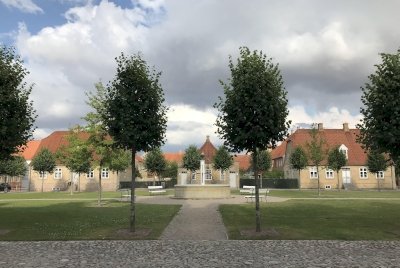
I visited this little town in the summer of 2021 when I covered all the inscribed sites on Denmark proper and a few tentative sites. I decided to stay overnight here and rented a room in the Brødremenighedens Hotel, probably the only hotel in town. It is not cheap (as all hotels in Denmark) but it is in one of the largest historic buildings in town and features not only a restaurant (with a UNESCO-Menue!) and several historic halls. I figure you can see them also without being a guest. There were several reasons I decided to stay overnight: It fit decently with my travel route coming south from the eastern centre of Jutland (coming from Aarhus over Jelling) and, as strange as it sounds, because I knew that there was not very much to see. I hate it when I look back disappointedly at a visit to a WHS, knowing that I missed a kew element that might have improved the impression. So when I visit a while a large WHS like an inscribed city I know I needs several visits to cover all interesting parts so I have to come back anyway. On the other hand when I visit a small site I like to make sure I see all (possibly) important parts so I don't have to go home with the feeling that I should got there again to see a missed part.
As has been mentioned by other reviewers you can mainly walk around the little town centre and the cemetery but there are few interiors and museum spaces you can visit: There is the church building and a few cafes you can enter and a museum Christiansfeld | Museum Kolding in the old brethren house, where the unmarried young men lived together, but all of them have different and limited opening hours. Since a short afternoon visit would not have allowed me to see the church and the museum because of the opening hours I decided to explore the town at slow space for an evening and a morning, hoping the town would reveal more of its hidden, "intangible" charms to the lingering visitor.
When I arrived in the late afternoon I checked in and went straight to the main plaza with the church and the museum. The church was open: It is a huge but intentionally plain space so there is not much more to do then to get a feeling for the very protestant space of worship. After that I walked happily around the centre, exploring all the old wooden buildings, the accessible parks and gardens, the cemetery and had a simple dinner at one of the pubs. The next morning, after another walk I visited the museum. It gives you some good information about the Moravians, their history, their traditions and crafts and about some of the other Moravian settlements. There isn't that much new if you have done some preparation before coming but it is nice enough and the best thing is centainly that you can walk around the large building with different floors and halls. Really impressive is the choir hall with an incredible acoustic.
While I enjoyed my laid-back half day in this little time capsule I still think this is a rather weak site. It is often mentioned that, since it is a rather weak site, a serial inscription would make more sense. I am not sure about that: Since there seems to be an agreement that this is clearly the best of the Moravian towns I do not see what would be gained by adding even smaller und weaker settlements. I think it makes more sense to inscribe the best example of a kind as has probably been done here instead of combining many weak elements to make up a site that is still weak though this seems more and more the tactic that countries use to gain an new inscription. Nonetheless I would like to visit a few more of the Moravian and Herrenhäuser settlements if I get the opportunity. When I checked them on the web it was quite clear that they were all even smaller then the small centre of Christiansfeld.
One settlement I had visited the year before was Neuwied near Koblenz: There is still a Herrenhuter church and one street with a few buildings but it is within the town and there is no seperate settlement. What I found very interesting though was the Roentgen-Museum: This family of carpenters (with the father Abraham and the even more famous son David) had a workshop in Neuwied and made some of the most famous furniture of the 18th century being in high demand for kings and emperors, including Napoleon and Cathrine the Great. They were the continental Chippendales. The fathers story I found remarkable: he was a Herrenhuter but got so successful that he had to leave the community since his wealth was not compatible with the doctrines of poverty of his church. But when he retired he returned to Herrenhut and his former community. BTW, another beautiful collections of Roentgen furniture can be seen in the stunning David Collection in Copenhagen that is mainly famous for its huge collection of Islamic art.
Comments
No comments yet.
